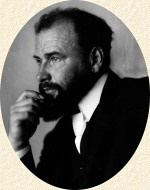|
Gustav Klimt, who is considered an outstanding master of the Fin de Siècle and highly esteemed artist of Symbolism, was an Austrian painter and graphic artist of Viennese Art Nouveau.
Born on July 14, 1862 in Baumgarten near Vienna.
Died on February 06, 1918 in Vienna.
During all of his lifetime, Gustav Klimt, the eldest son of a goldsmith, remained indirectly stuck with his father's trade. After completing an education with Mr. Laufberger, the chief master of decorative painting, he worked together with his brother in a studio for wall decoration, until his brother's death. This work influenced his paintings, which were characterized by their large ornamental and decorative surfaces. His early work was still strongly rooted in the classical academic painting. In 1897, Gustav Klimt founded the Viennese Secession along with Joseph Maria Olbrich and Josef Hoffmann, which constituted a significant backlash to the historicism of the academy. Gustav Klimt became famous for his portraits of women that radiate a subtle eroticism, capturing by a strange ornamental background. After leaving the Vienna Secession in 1905, he became the most sought-after portrait painter of the high society. In his landscapes, the painter combined impressionist and symbolist styles. With great fondness, he loved incorporating gold leaf in his paintings. |
 |
|
|